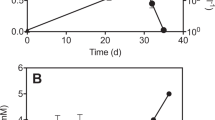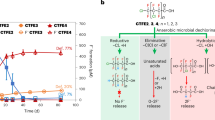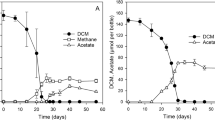Abstract
Tetrachloroethene (PCE) and trichloroethene (TCE) are ideal solvents for numerous applications, and their widespread use makes them prominent groundwater pollutants. Even more troubling, natural biotic and abiotic processes acting on these solvents lead to the accumulation of toxic intermediates (such as dichloroethenes) and carcinogenic intermediates (such as vinyl chloride)1,2,3,4. Vinyl chloride was found in at least 496 of the 1,430 National Priorities List sites identified by the US Environmental Protection Agency, and its precursors PCE and TCE are present in at least 771 and 852 of these sites, respectively5. Here we describe an unusual, strictly anaerobic bacterium that destroys dichloroethenes and vinyl chloride as part of its energy metabolism, generating environmentally benign products (biomass, ethene and inorganic chloride). This organism might be useful for cleaning contaminated subsurface environments and restoring drinking-water reservoirs.
This is a preview of subscription content, access via your institution
Access options
Subscribe to this journal
Receive 51 print issues and online access
$199.00 per year
only $3.90 per issue
Buy this article
- Purchase on Springer Link
- Instant access to full article PDF
Prices may be subject to local taxes which are calculated during checkout


Similar content being viewed by others
References
Kielhorn, J., Melber, C., Wahnschaffe, U., Aitio, A. & Mangelsdof, I. Vinyl chloride: still a cause for concern. Environ. Health Perspect. 108, 579–588 (2000)
Mohn, W. W. & Tiedje, J. M. Microbial reductive dehalogenation. Microbiol. Rev. 56, 482–507 (1992)
Roberts, A. L. et al. Reductive elimination of chlorinated ethylenes by zero-valent metals. Environ. Sci. Technol. 30, 2654–2659 (1996)
Vogel, T. M., Criddle, C. S. & McCarty, P. L. Transformation of halogenated aliphatic compounds. Environ. Sci. Technol. 21, 722–736 (1987)
US Environmental Protection Agency. Agency for Toxic Substances and Disease Registry, ToxFAQs for chlorinated ethenes; http://www.atsdr.cdc.gov/tfacts70.html (1996).
Coleman, N. V., Mattes, T. E., Gossett, J. M. & Spain, J. C. Phylogenetic and kinetic diversity of aerobic vinyl chloride-assimilating bacteria from contaminated sites. Appl. Environ. Microbiol. 68, 6162–6171 (2002)
Coleman, N. V., Mattes, T. E., Gossett, J. M. & Spain, J. C. Biodegradation of cis-dichloroethene as the sole carbon source by a β-Proteobacterium. Appl. Environ. Microbiol. 68, 2726–2730 (2002)
Holliger, C., Wohlfarth, G. & Diekert, G. Reductive dechlorination in the energy metabolism of anaerobic bacteria. FEMS Microbiol. Rev. 22, 383–398 (1998)
Löffler, F. E., Cole, J. R., Ritalahti, K. M. & Tiedje, J. M. in Dehalogenation: Microbial Processes and Environmental Applications (eds Häggblom, M. M & Bossert, I. D.) 53–87 (Kluwer Academic, New York, 2003)
Maymó-Gatell, X., Chien, Y.-T., Gossett, J. M. & Zinder, S. H. Isolation of a bacterium that reductively dechlorinates tetrachloroethene to ethene. Science 276, 1568–1571 (1997)
He, J. et al. Acetate versus hydrogen as direct electron donors to stimulate the microbial reductive dechlorination process at chloroethene-contaminated sites. Environ. Sci. Technol. 36, 3945–3952 (2002)
He, J., Ritalahti, K. M., Aiello, M. R. & Löffler, F. E. Complete detoxification of vinyl chloride (VC) by an anaerobic enrichment culture and identification of the reductively dechlorinating population as a Dehalococcoides population. Appl. Environ. Microbiol. 69, 996–1003 (2003)
Adrian, L., Szewzyk, U., Wecke, J. & Görisch, H. Bacterial dehalorespiration with chlorinated benzenes. Nature 408, 580–583 (2000)
Hendrickson, E. R. et al. Molecular analysis of Dehalococcoides 16S ribosomal DNA from chloroethene-contaminated sites throughout North America and Europe. Appl. Environ. Microbiol. 68, 485–495 (2002)
Cupples, A. M., Spormann, A. M. & McCarty, P. L. Growth of a Dehalococcoides-like microorganism on vinyl chloride and cis-dichloroethene as electron acceptors as determined by competitive PCR. Appl. Environ. Microbiol. 69, 953–959 (2003)
Duhamel, M. et al. Comparison of anaerobic dechlorinating enrichment cultures maintained on tetrachloroethene, trichloroethene, cis-dichloroethene and vinyl chloride. Water Res. 36, 4193–4202 (2002)
Gribble, G. W. in Chlorinated Compounds in the Biosphere, Natural Production (ed. Meyers, R. A.) 972–1035 (Wiley, New York, 1998)
Keppler, F., Borchers, R., Pracht, J., Rheinberger, S. & Scholer, H. F. Natural formation of vinyl chloride in the terrestrial environment. Environ. Sci. Technol. 36, 2479–2483 (2002)
Lendvay, J. M. et al. Bioreactive barriers: bioaugmentation and biostimulation for chlorinated solvent remediation. Environ. Sci. Technol. 37, 1422–1431 (2003)
Löffler, F. E., Ritalahti, K. M. & Tiedje, J. M. Dechlorination of chloroethenes is inhibited by 2-bromoethanesulfonate in the absence of methanogens. Appl. Environ. Microbiol. 63, 4982–4985 (1997)
Löffler, F. E., Tiedje, J. M. & Sanford, R. A. Fraction of electrons consumed in electron acceptor reduction and hydrogen threshold as indicators of halorespiratory physiology. Appl. Environ. Microbiol. 65, 4049–4056 (1999)
Gerhardt, P. (ed.) Manual of Methods for General Bacteriology (American Society for Microbiology, Washington DC, 1981)
Sung, Y. et al. Characterization of two tetrachloroethene-reducing, acetate-oxidizing anaerobic bacteria and their description as Desulfuromonas michiganensis sp. nov. Appl. Environ. Microbiol. 69, 2964–2974 (2003)
Löffler, F. E., Sun, Q., Li, J. & Tiedje, J. M. 16S rRNA gene-based detection of tetrachloroethene (PCE)-dechlorinating Desulfuromonas and Dehalococcoides species. Appl. Environ. Microbiol. 66, 1369–1374 (2000)
Bunge, M. et al. Reductive dehalogenation of chlorinated dioxins by an anaerobic bacterium. Nature 421, 357–360 (2003)
Acknowledgements
Electron micrographs were obtained by R. P. Apkarian at the Integrated Microscopy and Microanalytical Facility at Emory University, Atlanta, Georgia. This work was supported by the Strategic Environmental Research and Development Program, and by a National Science Foundation CAREER award to F.E.L.
Author information
Authors and Affiliations
Corresponding author
Ethics declarations
Competing interests
The authors declare that they have no competing financial interests.
Rights and permissions
About this article
Cite this article
He, J., Ritalahti, K., Yang, KL. et al. Detoxification of vinyl chloride to ethene coupled to growth of an anaerobic bacterium. Nature 424, 62–65 (2003). https://doi.org/10.1038/nature01717
Received:
Accepted:
Issue Date:
DOI: https://doi.org/10.1038/nature01717
This article is cited by
-
Interspecies metabolite transfer and aggregate formation in a co-culture of Dehalococcoides and Sulfurospirillum dehalogenating tetrachloroethene to ethene
The ISME Journal (2021)
-
Microbial debromination of hexabromocyclododecanes
Applied Microbiology and Biotechnology (2021)
-
Pollution and biodegradation of hexabromocyclododecanes: A review
Frontiers of Environmental Science & Engineering (2020)
-
Anaerobic 1,4-dioxane biodegradation and microbial community analysis in microcosms inoculated with soils or sediments and different electron acceptors
Applied Microbiology and Biotechnology (2020)
-
Growth of Dehalococcoides spp. and increased abundance of reductive dehalogenase genes in anaerobic PCB-contaminated sediment microcosms
Environmental Science and Pollution Research (2020)
Comments
By submitting a comment you agree to abide by our Terms and Community Guidelines. If you find something abusive or that does not comply with our terms or guidelines please flag it as inappropriate.



